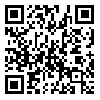پنجشنبه 26 تیر 1404
[Archive]
دوره 13، شماره 3 - ( 4-1404 )
جلد 13 شماره 3 صفحات 0-0 |
برگشت به فهرست نسخه ها
Download citation:
BibTeX | RIS | EndNote | Medlars | ProCite | Reference Manager | RefWorks
Send citation to:



BibTeX | RIS | EndNote | Medlars | ProCite | Reference Manager | RefWorks
Send citation to:
Noroozi Homayoon M, Gohari F, Sadri Damirchi E. Developing a Self-harm Model Based on Cognitive Emotion Regulation and Childhood Trauma with the Mediating Role of Insecure Attachment Styles in Students of Ardabil City, Iran: A Descriptive Study. PCP 2025; 13 (3)
URL: http://jpcp.uswr.ac.ir/article-1-1017-fa.html
URL: http://jpcp.uswr.ac.ir/article-1-1017-fa.html
Developing a Self-harm Model Based on Cognitive Emotion Regulation and Childhood Trauma with the Mediating Role of Insecure Attachment Styles in Students of Ardabil City, Iran: A Descriptive Study. Practice in Clinical Psychology. 1404; 13 (3)
چکیده: (59 مشاهده)
Objective: This study aimed to develop a structural model explaining self-harm based on cognitive emotion regulation and childhood trauma, with the mediating role of attachment styles among students in Ardabil City, Iran.
Materials and Methods: This applied study, in terms of its objective, employed a descriptive-correlational research design, utilizing structural equation modeling. The exogenous variables were cognitive emotion regulation and childhood trauma, while self-harm served as the endogenous variable, with insecure attachment styles functioning as the mediating variable. The statistical population consisted of secondary school students aged 15 to 18 residing in Ardabil during the fall semester of the 2024 academic year. The research instruments included the self-harm inventory, cognitive emotion regulation questionnaire, childhood trauma questionnaire, and attachment styles scales.
Results: The results indicated that insecure attachment styles had a significant positive effect on self-harm (β = 0.534; P < 0.01). Also, cognitive emotion regulation exerted a significant negative effect on self-harm (β = -0.488; P < 0.001), whereas childhood trauma had a significant positive effect on self-harm (β = 0.462; P < 0.001). Additionally, cognitive emotion regulation (β = 0.277; P < 0.05) and childhood trauma (β = 0.233; P < 0.05) had a significant indirect effect on self-harm through the mediation of insecure attachment styles.
Conclusion: The findings suggest that childhood trauma and deficiencies in cognitive emotion regulation affect self-harm among students with insecure attachment styles, playing a mediating role. These results highlight the importance of cognitive-emotional mechanisms and attachment experiences in both the prevention and better understanding of self-harm behaviors.
Materials and Methods: This applied study, in terms of its objective, employed a descriptive-correlational research design, utilizing structural equation modeling. The exogenous variables were cognitive emotion regulation and childhood trauma, while self-harm served as the endogenous variable, with insecure attachment styles functioning as the mediating variable. The statistical population consisted of secondary school students aged 15 to 18 residing in Ardabil during the fall semester of the 2024 academic year. The research instruments included the self-harm inventory, cognitive emotion regulation questionnaire, childhood trauma questionnaire, and attachment styles scales.
Results: The results indicated that insecure attachment styles had a significant positive effect on self-harm (β = 0.534; P < 0.01). Also, cognitive emotion regulation exerted a significant negative effect on self-harm (β = -0.488; P < 0.001), whereas childhood trauma had a significant positive effect on self-harm (β = 0.462; P < 0.001). Additionally, cognitive emotion regulation (β = 0.277; P < 0.05) and childhood trauma (β = 0.233; P < 0.05) had a significant indirect effect on self-harm through the mediation of insecure attachment styles.
Conclusion: The findings suggest that childhood trauma and deficiencies in cognitive emotion regulation affect self-harm among students with insecure attachment styles, playing a mediating role. These results highlight the importance of cognitive-emotional mechanisms and attachment experiences in both the prevention and better understanding of self-harm behaviors.
نوع مطالعه: پژوهشي |
موضوع مقاله:
رويكرد تحليلي
دریافت: 1404/2/17 | پذیرش: 1404/4/10 | انتشار: 1404/4/20
دریافت: 1404/2/17 | پذیرش: 1404/4/10 | انتشار: 1404/4/20
| بازنشر اطلاعات | |
 |
این مقاله تحت شرایط Creative Commons Attribution-NonCommercial 4.0 International License قابل بازنشر است. |



